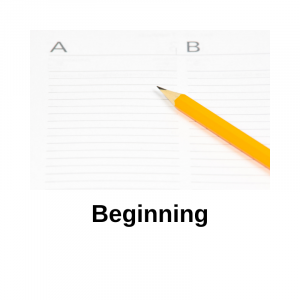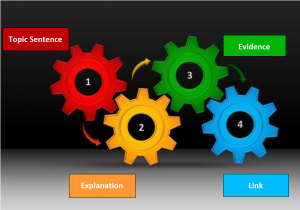22 Basic Paragraph Writing
A paragraph is a distinct and separate piece of writing that forms part of an overall text. Each paragraph contains one key idea or topic and at least one controlling idea. When writing a larger text, such as an essay, the writer must also consider how the ideas in each paragraph connect to each other. Types of Academic Writing are discussed in Chapter 15 of this resource, therefore this chapter examines only the BODY paragraph.
This chapter explores a useful academic structure for a basic body paragraph and the elements that contribute to its cohesiveness.

Beginner writers should follow the simple acronym explained below (TEEL) as it will help to organise your academic writing and make the meaning and aim of each paragraph clear to the reader.

Intermediate writers should work towards refining sentence structures and academic language choices to develop more cohesive and coherent paragraphs.

Experienced writers should consider how they can augment the basic paragraph structure with more sophisticated examples, linking arguments, and logical conclusions.
Many readers of this chapter may have already encountered the T.E.E.L. (or P.E.E.L.) structure of a body paragraph in school and have a good understanding of general paragraph structure, however, now would be a good opportunity to refresh your memory. Review the following diagram that demonstrates where the acronym comes from:
T – Topic sentence with a controlling idea
E – Explain and make a claim (about the controlling idea)
E – Evidence from academic sources (plus evaluate how this supports the claim)
L – Link back to the key idea or argument (or to the topic of the next paragraph)
This simple paragraph structure will introduce your ideas to the reader, add additional explanations and evidence for support and then link all this information back to the main idea of the overall paragraph or essay. Perhaps it could be more effectively displayed as a series of gears working together to make the whole machine move forward.
What is a topic sentence?
A topic sentence makes a connection between the overall topic or main idea of the essay and a controlling idea. For example, the overall topic of an essay could be sustainable energy. The controlling ideas might examine solar, wind, and hydro electricity. Each controlling idea becomes the basis for a paragraph, whereas the overall topic remains the same throughout the essay.
It is often taught that each new paragraph represents a new topic, though in actuality the topic remains the same and the controlling idea changes.
What is a controlling idea?
A controlling idea limits, restricts or controls what is being discussed in relation to the main topic.
For example:
Sustainable energy (topic) has long been a topic of discussion and solar energy (controlling idea), in particular, has had a great deal of attention.
This signals to the reader that the essay is about sustainable energy, though in this particular paragraph only solar energy will be discussed. Therefore, the topic is restricted to only solar energy (controlling idea). It may go on to discuss both the positive and negative attributes of solar energy, however, it is still being controlled by one idea.
In the next paragraph the topic would remain sustainable energy, but the controlling idea would change to wind power; the third paragraph would discuss hydro power. When you understand the building blocks behind good paragraph structure, the essay begins to write itself.
What am I explaining to the reader?
The next sentence or sentences should elaborate on the controlling idea and may make an assertion or claim about it.
For example:
Modern Australian home owners are turning to solar panels to offset their electricity costs (fact), however, their effectiveness is greatly depleted in sustained cloudy weather (claim).
What is the evidence meant to support?
Given that the claim is often unsupported initially, the next sentences should provide supporting information for the controlling idea and the claim made in relation to it.
For example:
According to Energy Australia (2020)[2] solar panels operate at 10-25% capacity in cloudy weather, although this varies depending on the type of panel.
Writers can build on their discussion or argument by adding more evidence to support the claim. Use reputable academic sources (refer to Chapter 14).
What am I evaluating?
It is important not to assume that the reader will make the mental connection between the claim and the evidence. Therefore, evaluate the relevance and explicitly state the connection to the reader.
For example:
This demonstrates that solar energy, while environmentally supportive, may not be a solution to all of Australia’s energy needs.
How do I link my topic, claim, and evidence?
If we use the analogy of the gears working together, think of the linking sentence as the one that turns back in on the contents of the paragraph and locks it all together.
For example:
Sustainable energy is currently being debated and solar power offers one alternative, though it may be less productive on cloudy days depending on the quality of solar panels being installed on Australians’ rooves.
A linking sentence can also be used to draw the reader onto the next paragraph and provide a mental bridge between controlling ideas for the reader. This creates good cohesion and coherence throughout the essay.
For example:
While there are benefits to using solar energy to offset household electricity costs, even if somewhat inconsistent in cloudy weather, wind power (next controlling idea) also offers a more sustainable energy source than our finite fossil fuel supplies.
The next paragraph could discuss how wind power is infinite and therefore far more sustainable than fossil fuels.
Now let’s put it all together:
Sustainable energy (topic) has long been a topic of discussion and solar energy (controlling idea), in particular, has had a great deal of attention. Modern Australian home owners are turning to solar panels to offset their electricity costs (fact), however, their effectiveness is greatly depleted in sustained cloudy weather (claim). According to Energy Australia (2020) solar panels operate at 10-25% capacity in cloudy weather, although this varies depending on the type of panel (evidence). This demonstrates that solar energy, while environmentally supportive, may not be the solution to all of Australia’s energy needs (evaluation and explanation of evidence). **Sustainable energy is currently being debated and solar power offers one alternative, though it may be less productive on cloudy days depending on the quality of solar panels being installed on Australians’ rooves (links back to claim).
Or
**While there are benefits to using solar energy to offset household electricity costs, even if somewhat inconsistent in cloudy weather, wind power (next controlling idea) also offers a more sustainable energy source than our finite fossil fuel supplies (links to next controlling idea in the essay).
Recap
These are the basics of writing a well structured academic body paragraph. Repeat this process to structure an essay that demonstrates a logical progression of thoughts, claims, and supporting evidence. T.E.E.L. is an easy acronym to remember and great to fall back on if you begin to get a little lost in your writing. You can augment your paragraphs with further evidence, explanations, and elaborations; you are not limited to only two “E” sentences.

controls, restricts, or limits what will be discussed in relation to the topic
unified or united
logically connected; consistent
add to; enlarge; strengthen
verb - add details; expand
a statement or declaration as if something is true, often without support or reason
researched, reliable, written by academics and published by reputable publishers; often, but not always peer reviewed


